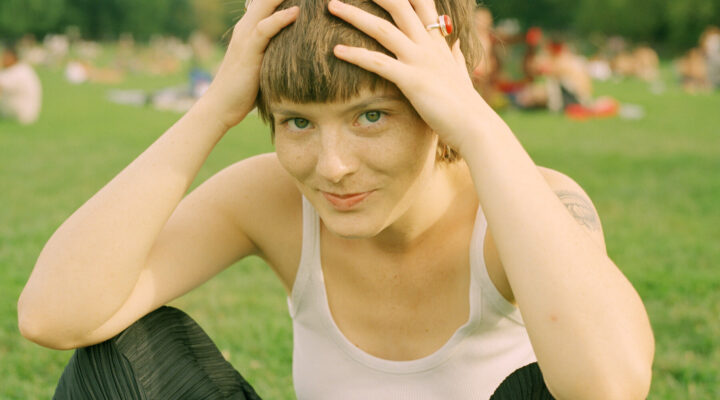Yinging and Yanging and Puffing on Disaster
Opinion Piece by Michelle Parrot
Along comes something—launched in context.
How do we understand this boundary?
Let’s begin by posing it as a dilemma.
The term comes from the Greek, dilemmatos, and means “involving
two assumptions,” and so we begin by proposing that the
boundary is not an edge but a conjunction—that the dilemma
bears the meaning of conjunction: encounter, possible confusion,
alteration exerted through reciprocal influence, etc.—the kind of
situation that is typical, I might add, along borders between nations,
between speakers of different languages, between neighboring
ecosystems, etc.
— Lyn Hejinian, The Language of Inquiry
THE THREE LAWS OF PARADOX
(SELF-REFERENCE, CONTRADICTION, VICIOUS CIRCULARITY/ INFINITE REGRESS)
Cats—lords of the fundamentally irrational, the blasphemous, the mystery. They serve no master and are free to pursue their own idiosyncratic whimsy and unfettered pleasure. Their means are as circuitous as their ends.
The feline seem to possess an innate proclivity for edge, and denote this principle with their entire physicality. Whiskers and fur are sensory organs which nuance the cat’s sense of its own boundaries. Like a dancer, a cat is acutely aware of its body in relation to space. When cats find themselves in an unfamiliar room they prefer to walk along the periphery to reach their objective, as opposed to cutting directly through the middle, marking their passage by rubbing their cheeks and flanks on walls, couches, and legs.
The cat is very comfortable embodying aesthetic extremes, raising the hysteria of tension to the point of absurdity or humor. Perched in perfect balance on the slightest hint of a railing, the arrogant cat defies gravity. Precarity. Like a bowstring tensed before release: the higher the perch, the more deadly potential energy is contained within the cat’s body (the higher the heel the closer to God). Further abstracted, the cats’ body can be imagined as a three dimensional globe balanced on the railing, a two dimensional line. Logical impossibility. Drop a paper on the floor and the cat will almost invariably lay on it, artfully composed. The cat on this plane is at once signifier and signified, an autonomous loop.[1]
LABYRINTH
I have recently, accidentally, as a side effect of my pleasant nightly ritual, which includes vaping pure THC oil and lying very still so my skittish cat will climb into bed with me, learned to listen and speak in the feline tongue.
One night, while we were busy with our circuitous rituals of relation, it occured to me that, because she is fluid and indeterminate, and because of her proclivity for the edge, and because it is her kin the sphinx whose riddles grant Oedipus entrance to Thebes, my cat is uniquely equipped to retrieve the answer to the paradox. It seemed evident to me that the cat is a born interloper, and can therefore cross the ocean of difference between form and matter.[2]
Purring, weaving widening circles of being around my neck, she teased the space between us. “Maybe it is easier to describe all that surrounds the indescribable merely by nature of it surrounding,” she responded. Circumnavigation of pleasure. Now she is far enough away that I must stretch beyond myself to just graze her fur with my barest fingertips.
“There is an important distinction between maze and labyrinth: maze refers to a complex branching (multicursal) puzzle with choices and paths and direction.
A labyrinth (unicursal) has only one singular path. This path orbits around a fixed point in the middle, spiraling into itself. There are no dead ends but there are also no corners, no landmarks, no recognizable patterns: you walk in circles, until you become dislodged, still on path but out of space, a new type of lost.
Unlike a maze it is not an act of will, intelligence or determination to reach the end. The end is inevitable. The end is where your problems really begin.”
The ritual reaches a familiar fever pitch. Her thin gash of a body arches and tenses in a frenzy of motion, drawing velvet arcs in the still night air as she comes into contact with the absolute.
(This piece is in dialogue with, and contains fragments from, a paragraph from a text found in Rock & Rose #8, a zine compiled by artist Chloe Maratta, author unknown.)
TEMPERANCE THE ANDROGYNE
Temperance the androgyne, winged, white-robed, touching earth and heaven, appears. Their wings are flame and a radiance of gold is about their head. On their breast they wear the sacred sign of the book of the Tarot—a triangle within a square, a point within the triangle[3]; on their forehead the symbol of life and eternity, the circle.
In one hand is a cup of silver, in the other a cup of gold, and there flows between these cups a constant, glistening stream of every color of the rainbow. But I could not tell from which cup nor into which cup the stream flowed.
In great awe I understood that I was near the ultimate mysteries from which there is no return. I looked upon the angel, upon their symbols, their cups, the rainbow stream between their cups—and my human heart trembled with fear and my human mind shrank with anguish and lack of understanding.
“Yes”, says the voice, “this is a mystery that is revealed at Initiation. ‘Initiation’ is simply the revealing of this mystery in the soul. The Hermit receives the lantern, the cloak and the staff so that he can bear the light of this mystery.
But you probably came here unprepared. Look then and listen and try to understand, for now understanding is your only salvation. He who approaches the mystery without complete comprehension will be lost.”
The name of the angel is Time. The circle on the forehead is the symbol of eternity and life. Each life is a circle which returns to the same point where it began. Death is the return to birth. And from one point to another on the circumference of a circle the distance is always the same, and the further it is from one point, the nearer it will be to the other. Eternity is a serpent, pursuing its tail, never catching it.
One of the cups the angel holds is the past, the other is the future. “The rainbow stream between the cups is the present. You see that it flows both ways. This is Time in its most incomprehensible aspect.
Men think that all flows constantly in one direction. They do not see that everything perpetually meets and that Time is a multitude of turning circles. Understand this mystery and learn to discern the contrary currents in the rainbow stream of the present.”
The symbol of the sacred book of the Tarot on the angel’s breast is the symbol of the correlation of God, Man and the Universe.
The triangle is God, the world of spirit, the world of ideas, or the noumenal world[4]. The point within the triangle is the soul of man. The square is the visible world. The consciousness of man is the spark of divinity, a point within the triangle of spirit. Therefore the whole square of the visible universe is equal to the point within the triangle.
The world of spirit is the triangle of the twenty-one signs of the Tarot. The square represents fire, air, water and earth, and thus symbolizes the world. All this, in the form of the four symbols, is in the bag of the Fool, who himself is a point in a triangle. Therefore a point without dimension contains an infinite square.
(Adapted from ‘The Symbolism of the Tarot’ by Russian esoteric P.D. Ouspensky)
Footnotes
- In geometry, the point–line–plane postulate is a collection of assumptions (axioms) that can be used in a set of postulates for Euclidean geometry in two (plane geometry), three (solid geometry) or more dimensions.
- From the beginning of philosophical thought, femaleness was symbolically associated with what Reason supposedly left behind—the dark powers of the earth goddesses, the immersion in the unknown forces associated with mysterious female powers. The Greek saw the capacity to conceive as connecting the female body with Nature. ‘Woman,’ Plato shouts from his cave, ‘imitates the earth.’
Aristotle, in his Metaphysics, cites The Pythagorean Table of Opposites, a theory which neatly parses the entirety of the universe into 10 pairs of contrasting attributes. Vague, oblong, dark, secret, twisted, ever-moving, not-self-contained and lacking-its-own-boundaries are placed on the same side of the table as evil, female and passive, contrasting male attributes such as active, good, light, and retaining-its-form. For the Pythagoreans, femaleness was explicitly linked with the unbounded, the irregular, the vague and indeterminate, that which is difficult or impossible to pin down in space and time, the stuff of the earth, as opposed to the precise, sharp edged, and bound male principle of the platonic ideal. - The triangle is God (the Trinity) or the world of ideas, or the noumenal world . The point is man’s soul. The square is the visible, physical or phenomenal world.
- Noumenon, plural noumena, in the philosophy of Immanuel Kant, the thing-in-itself (das Ding an sich) as opposed to what Kant called the phenomenon—the thing as it appears to an observer.



